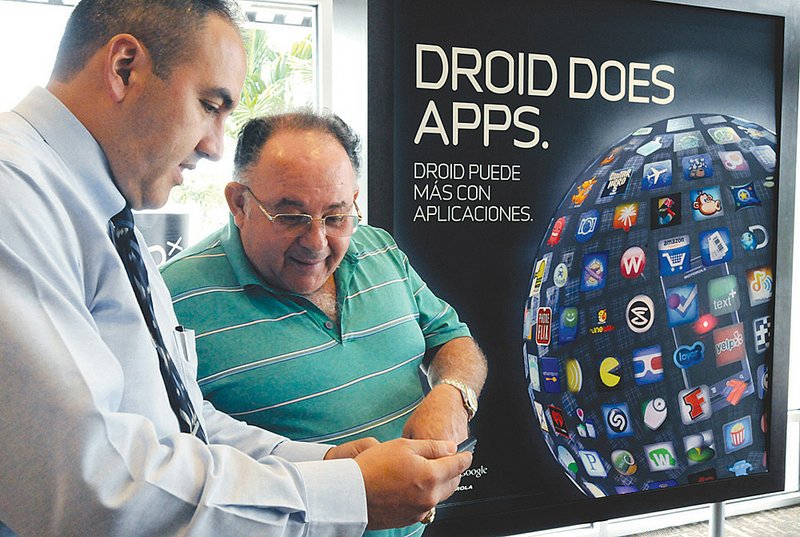MIAMI — The country is in the midst of an Android invasion, and there’s no sign of it slowing down.
Since late April, more than a dozen new smart phones - most of them running Google’s Android operating system - have hit stores.
Apple’s iPhone 4 with service on AT&T has grabbed the most media buzz of all the new smart phones, with customers still occasionally finding some stores out of stock. But competitor phones with Android systems have also flown out of stores, including Verizon’s Droid Incredible and Droid X, Sprint’s Evo and Epic, T-Mobile’s HD2 and Vibrant, and AT&T’s Captivate.
Throw in the launch of a new touch-screen BlackBerry, and 2010 has shaped up as an unprecedented bonanza for consumers and smart-phone makers.
“I think the appetite for smart phones has exceeded what we expected,” Verizon spokesman Chuck Hamby said.
This year, more Android phones are on the market boasting iPhone-like features, and some have hardware that the iPhone lacks - like slideout keyboards, higher-megapixel cameras or the ability to act as a mobile Wi-Fi hotspot for other devices.
The result: Consumers arebuying Android phones at a faster pace than iPhones.
Android phones accounted for 33 percent of all smart phones purchased in the United States in the second quarter of 2010, ahead of BlackBerry’s RIM with 28 percent and Apple’s iPhone with 22 percent of the market, according to research company NPD Group.
In August, Google Chief Executive Off icer Eric Schmidt reported about 200,000 Android devices were sold a day - double from two previous months.
Every few weeks since the end of April, a new smart phone has been introduced amid a flurry of advertising.AT&T and Verizon each offered four powerful, app-filled smart phones. Sprint and TMobile each introduced two phones - and have more on the way.
“One phone is not for everyone,” Hamby said. “Not everyone wants the [Droid] Incredible, even though it seemed that way. Not everyone wants the [Droid] X, even though it seems that way. The strategy is to offer something for everyone.”
But the seemingly endless stream of new choices can be aggravating - especially to status-conscious consumers.
“You buy a cell phone and you get locked into a two-year contract, and two months later it’s superseded by a better one,” said Andrew Eisner, director of community and content for consumer electronics review and research company Retrevo Inc. “It can be very frustrating for the consumer.”
And confusing as well. While iPhone 4 offers a single interface, each Android interface varies with the phone model. Android phones builtby HTC have different home screen tools - called widgets - than Motorola’s or Samsung’s Android phones. Some phones have different menu controls than others or offer different pre-installed applications.
For example, Verizon’s Samsung Galaxy S Fascinate is the only Samsung Galaxy S phone that currently comes pre-programmed with Microsoft Bing search widgets instead of Google search widgets.
Network speed also has played heavily in purchasing choices. For the first time, phones are being crafted to run at faster-than-3G data speeds. Sprint has two phones - Evo and Epic - that run on its new 4G network. Yet 4G - touted to run up to 10 times faster than the current 3G network - isn’t yet widely available.
Hardware is the other battleground, where anything less than a 1GHz processor is sluggish, a camera without a flash is sub-par, and turning the phone into a mobile Wi-Fi hotspot is an increasingly common luxury.
The ability to view websites that use Adobe Flash to show animations and videocan sway a heavy Web user to go with Android, since Apple’s iPhone hasn’t supported Flash programming.
Bigger-is-better is another selling point. Both Verizon’s Motorola Droid X and Sprint’s Evo have a 4.3-inch screen, versus the iPhone 4’s 3.5-inch screen. And units in Samsung’s Galaxy S line all have 4-inch screens.
But the big hardware trend this season is two cameras - one on back, a second on the front, near the screen - for two-way video chatting. The iPhone 4 has it, and so do two of Sprint’s phones: the HTC Evo 4G and Samsung Epic 4G. For now, the technology is in an adolescent stage. IPhone 4 users can only video chat with other iPhone 4 users who are using a Wi-Fi connection to connect to the Internet (to avoid putting a burden on AT&T’s 3G wireless network). And Sprint’s phones require downloading a third-party application, like Qik or Fring.
Retrevo’s Eisner said he thought he’d use video chatting more often with his Evo, but “It’s kind of a hassle. It’s just easier to make a phone call.”
Whether a consumer picksan iPhone, a BlackBerry or a handset with an Android operating system, he is likely to stick with it for some time. Apps bought on the iPhone won’t work on Android or BlackBerry, and vice versa - making it less appealing to jump ship after two years.
Business, Pages 23 on 09/27/2010
